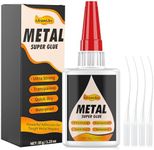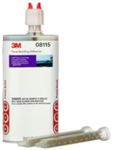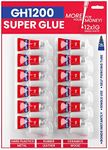Buying Guide for the Best Glue For Metals
Choosing the right glue for metals can make a big difference in how strong and durable your bond will be. Not all glues are created equal, and metals have unique properties that require specific adhesives. When picking a glue, you should consider what metals you are joining, the conditions the bond will face (like heat, moisture, or stress), and how permanent you want the bond to be. Understanding the key specifications will help you select the best glue for your project and ensure a successful result.Adhesive TypeThe type of adhesive refers to the chemical makeup and bonding method of the glue. For metals, common types include epoxy, cyanoacrylate (super glue), polyurethane, and specialized metal adhesives. Epoxy is known for its strength and durability, making it suitable for heavy-duty or load-bearing applications. Cyanoacrylate is quick-setting and good for small repairs but may not hold up under stress or heat. Polyurethane is flexible and can handle some movement, while specialized metal adhesives are designed for specific metals or conditions. To choose the right type, think about the strength you need, how quickly you want the glue to set, and whether the bond will face movement or harsh environments.
Cure TimeCure time is how long it takes for the glue to reach its full strength after application. Some glues set in seconds but take hours or even days to fully cure. Fast-setting glues are convenient for quick fixes, but slower-curing adhesives often create stronger, more durable bonds. If your project needs to be handled or stressed soon after gluing, look for a fast-curing option. For the strongest bond, especially for structural or load-bearing uses, be patient and allow for a longer cure time.
Temperature ResistanceTemperature resistance tells you how well the glue can handle heat or cold without losing its strength. Some adhesives soften or break down at high temperatures, while others become brittle in the cold. If your metal bond will be exposed to heat (like in engines or outdoor settings), choose a glue with high temperature resistance. For indoor or decorative projects, this may be less important. Always match the glue’s temperature range to the environment where the bond will be used.
Water and Chemical ResistanceThis specification indicates how well the glue can withstand exposure to water, oils, or chemicals. Some glues are waterproof and can be used outdoors or in wet environments, while others may weaken or dissolve when exposed to moisture or chemicals. If your metal project will be outside, in a kitchen, or near chemicals, prioritize a glue with strong water and chemical resistance. For indoor, dry, or decorative uses, this may be less critical.
Bond StrengthBond strength measures how much force the glued joint can withstand before breaking. This is usually given in pounds per square inch (PSI) or a similar unit. High bond strength is important for structural or load-bearing applications, while lower strength may be fine for light repairs or crafts. Consider what the glued metals will be used for—if they need to support weight or handle stress, choose a glue with a high bond strength rating.
Gap Filling AbilityGap filling ability refers to how well the glue can fill spaces or uneven surfaces between metal parts. Some adhesives are thin and only work well on tightly fitting surfaces, while others can fill small gaps and still create a strong bond. If your metal pieces don’t fit perfectly together, look for a glue with good gap filling properties. For smooth, flush surfaces, this is less important.


















